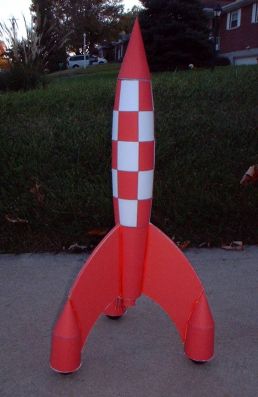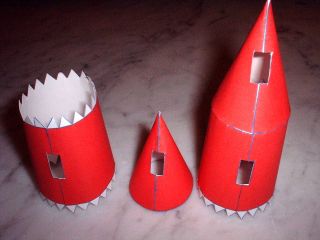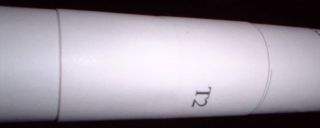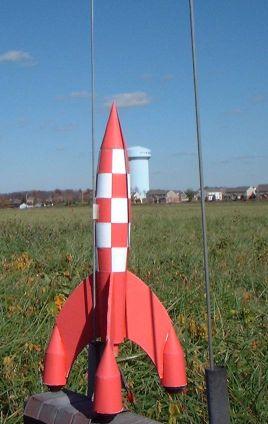| Construction Rating: | starstarstarstarstar_border |
| Flight Rating: | starstarstarstar_borderstar_border |
| Overall Rating: | starstarstarstarstar_border |
| Manufacturer: | Model Minutes  |

Brief:
Model Minutes specializes in paper rockets and this is one wild looking futuristic design. It clearly draws a lot of looks at the pad and no one will believe it is made of paper.
Construction:
The parts list is pretty simple for this kit, just pre-printed cardstock patterns. Lots of them. There are also a few other items like foamboard for fins, some clay for nose weight, a motor hook, and a parachute kit of sorts, but basically this is a cardstock project.
Model Minutes is a Canadian company, and leans towards the French side of the cultural life. Their directions, translated from French, are improving quite a bit but still leave a little to be desired. If you've built a few paper rockets before, you will probably be able to handle this kit, but if you're not familiar with paper rocket construction (or at least origami), then I'd have to warn you of this one. It's at least a skill level 4 on the 1-5 difficulty scale.
One other aspect of Model Minutes instructions worth noting is that they come with color photos in 3D. Of course to see the 3D you have to wear the hokey red/blue tinted glasses, which makes seeing the rest of the instructions a pain, but it is an interesting innovation (and presumably copy protection).
Before beginning construction, it's worth reading the construction tips section. It's very important to understand some basic techniques to pull off a good-looking finish on this. The instructions offer good advice on how to roll tubes without wrinkling or kinks, how to achieve sharp lines for corners/edges, etc.
 The actual construction begins by forming the "shock absorbers", which are the pods mounted at the end of the fins. These are three part assemblies consisting of a basic cylinder, a cone top, and a round disk bottom. The cylinder and cone are bonded by folding over a bunch of little triangles and gluing them together as a joint (see photo of components and assembly). Given the number of components involved in this project, you'll need to plan on spending a lot of time with the scissors and knife cutting out all those parts (and triangle tooth joints).
The actual construction begins by forming the "shock absorbers", which are the pods mounted at the end of the fins. These are three part assemblies consisting of a basic cylinder, a cone top, and a round disk bottom. The cylinder and cone are bonded by folding over a bunch of little triangles and gluing them together as a joint (see photo of components and assembly). Given the number of components involved in this project, you'll need to plan on spending a lot of time with the scissors and knife cutting out all those parts (and triangle tooth joints).
Fins are cut from foamboard using a provided template. The fins as well as the shock absorbers are through-the-wall mounted, so the fins include slots/tabs for mounting. Cutting foamboard is tricky, and I learned the hard way on other kits not to use a basic utility knife. Instead, I use a fresh, extra-sharp X-Acto blade #11, which manages to cut the foam cleanly rather than tear it out from between the cardstock covering.
If you're really getting into it, there are also "optional" instructions for forming an airfoil in the foam. This is accomplished by cutting out some of the foam center on the leading and trailing edges, then forming a rounded top/leading edge and angled/wedge trailing edge by gluing the paper edges in place. I tried this on a small scrap section and honestly have no idea how to do this right because I couldn't pull off anything even resembling an airfoil. I wound up going with the basic squared edges.
The inner motor tube is too long to form from a single sheet of paper, so it's assembled by rolling two tubes and joining them with an external coupler. This was pretty straightforward.
The tail cone comes next and is a basic rolled pattern with a centering ring glued onto each end. It also gets slots cut for the fin mounting.
The body is very cool, tapered from top and bottom to a fat center. You'll never seen anything like that from a BT-anything kit. To pull this off though, you've got to roll 5 different boattail type sections and glue them together. Pay careful attention to the sequence, going bottom to top so that you can reach into the glue joint each time and apply pressure with your fingers.
The nose cone is a basic rolled cone pattern with a disk bottom. It gets a lot of nose weight for stability and is anchored in the tube by cutting a couple of foam circles, gluing them together, and gluing in a screw eye for attaching the shock cord.
The assembly of the various components is comparatively easy but takes some patience. This isn't something you can tack together with CA and fillet. Working with very thin applications of white glue might mean holding a joint for 90-120 seconds and there are plenty of glue joints on this.
 First, the motor/central tube is glued into the boat tail. Then, the fins are glued through the boat tail to the main tube. The "shock cord" is anchored to the main tube by cutting a small slit, slipping the rubber band through, and knotting the end of the rubber band. I thought this was a very weak approach, as the rubber band isn't going to survive many flights. Sure it's paper, but I've logged over 25 flights on my FlisKits Midnight Express and fully expect to get 20+ out of this one. I "upgraded" to a heavy elastic, sort of a rugged Estes type cord. The rest of the assembly consists of gluing the tapered body section to the boat tail, then gluing the shock absorbers/pods to the fins. I was surprised at how well the pods fit given the contours of the fins and the angles of the cones on top of the pods. Unlike most rocket construction projects, this one ends with the motor tube assembly. As you'd expect, it's done by rolling a paper tube. A metal motor hook is poked onto the tube and held in place with generous wrap of thread (masking tape would have worked fine). Finally, you get to roll your own centering rings out of a series of strips of paper. The finished assembly is then glued into the central tube.
First, the motor/central tube is glued into the boat tail. Then, the fins are glued through the boat tail to the main tube. The "shock cord" is anchored to the main tube by cutting a small slit, slipping the rubber band through, and knotting the end of the rubber band. I thought this was a very weak approach, as the rubber band isn't going to survive many flights. Sure it's paper, but I've logged over 25 flights on my FlisKits Midnight Express and fully expect to get 20+ out of this one. I "upgraded" to a heavy elastic, sort of a rugged Estes type cord. The rest of the assembly consists of gluing the tapered body section to the boat tail, then gluing the shock absorbers/pods to the fins. I was surprised at how well the pods fit given the contours of the fins and the angles of the cones on top of the pods. Unlike most rocket construction projects, this one ends with the motor tube assembly. As you'd expect, it's done by rolling a paper tube. A metal motor hook is poked onto the tube and held in place with generous wrap of thread (masking tape would have worked fine). Finally, you get to roll your own centering rings out of a series of strips of paper. The finished assembly is then glued into the central tube.
 One last comment I'd like to offer on the construction: the kit comes with a launch lug that's really just a 2" length of a plastic drinking straw. The straw is about 1/4" diameter. I liked that it's heavy duty but the plastic really doesn't bond well to the paper body with white glue and there aren't any straight lines on the body to bond to. I really think this could use a couple of normal launch lugs, one along the body and one mounted to a fin.
One last comment I'd like to offer on the construction: the kit comes with a launch lug that's really just a 2" length of a plastic drinking straw. The straw is about 1/4" diameter. I liked that it's heavy duty but the plastic really doesn't bond well to the paper body with white glue and there aren't any straight lines on the body to bond to. I really think this could use a couple of normal launch lugs, one along the body and one mounted to a fin.
Finishing:
Since the rocket was made from pre-printed patterns, there is no finishing involved in this. Try masking and painting the checkerboard pattern on this baby! That's one of the great advantages to paper rockets--great color and finish schemes without the time/headache of paints.
Construction Rating: 4 out of 5

Flight:
First flight was on a slightly windy day (about 8 mph). As I was prepping the rocket, the plastic straw launch lug broke loose, thus my beef with the material... I did a quickie repair using a regular 1/8" lug and CA. After allowing for the CA to cure, I then loaded in a C6-3 and headed out to the pad. At ignition, the rocket kind of struggled to get about halfway up the rod, hung there for a second or two, and then finally flew off with most of the thrust burned out. It climbed to a whopping 20-30 feet, went darned near horizontal, and plugged itself firmly into the ground nose first. It was at that point the ejection charge popped the body loose. It was straight out of the Road Runner and Coyote cartoons. Fortunately the ground was pretty soft from rain the day before and with all the clay packed into the nose, there was only minor wrinkling of the nose cone.
I wound up replacing the launch lug with a 3/16" lug mounted to the fin. This gets the lug back down below the CG and provides a more firm surface than the paper body. This made all the difference in the world, as flight #2 gracefully left the rod and went straight up on another C6-3. Unfortunately, the ejection charge blew through the side of the rocket rather than deploying the chute and this one pranged badly. With damage beyond repair, I cut it open to perform the autopsy. Cause of death was very likely a crimped or possibly torn inner/main tube from the first flight and the ejection charges wound up going out instead of up. This also led to a small fire, burning away a large portion of the tube.
Overall, I would have to conclude that it probably flies very well and I would strongly recommend the launch lug modification.
Recovery:
As mentioned, the rubber band shock cord is feeble and needs to be upgraded. I also wasn't too impressed with the plastic chute (about 15" and not enough shroud line to allow for even 8" lines). Instead, I clipped on one of my spare 18" chutes from my range box.
I can't really comment, though, on the effectiveness of my recovery upgrade, due to the prang from the flight.
Flight Rating: 3 out of 5
Summary:
Flight problem aside, I just love this kit. It's challenging to build but looks fantastic and is well worth the effort. I really don't think it will normally have any flight problems and blame my last minute lug substitution for the poor first flight.
I really think every serious rocketeer needs to build and fly at least a couple of paper rockets. This one's a real gem.
Overall Rating: 4 out of 5
Other Reviews
- Model Minutes XFLR-7 By Dick Stafford (January 20, 2009)
The XFLR-7 is a paper/foamboard kit patterned after the Tintin rocket from the Destination Moon comic. This is a cool design and should be considered a classic. Although the kit is now OOP, existing stock may be around for a while, so I decided to submit a review anyway. I hope that my observations will help in the construction of other paper/foamboard rockets whether they are ...
 |
 |